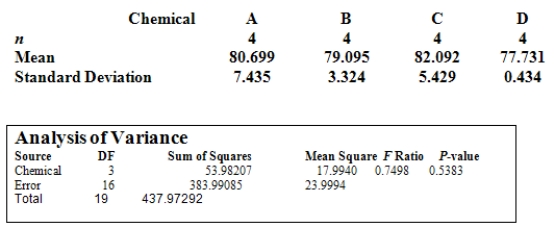Multiple Choice
Bleaching chemicals are used in the pulp and paper industry to increase the brightness of the paper that is produced.Four chemical agents were studied to determine their effect on the brightness of paper produced from pulp treated with the chemical.The following tables provide some details obtained from the experimental data.  The null hypothesis Ho:
The null hypothesis Ho:  was established for the ANOVA.
was established for the ANOVA.
If the null hypothesis is true,the ANOVA table shows that the P-value is 0.5383.What should we conclude from this?
A) The mean of Chemical D is certainly different from the mean of Chemical A.
B) Some of the chemicals have a different effect on the brightness of the paper.
C) The null hypothesis should be rejected in favor of the alternative hypothesis.
D) Caution should be exercised on any conclusion from the ANOVA because the assumption of equal standard deviation among chemicals may be suspect.
E) With only 19 degrees of freedom for total,nothing much can be concluded from this experiment.
Correct Answer:

Verified
Correct Answer:
Verified
Q54: A storeowner wishes to compare the average
Q55: At a large automobile factory,four different machines
Q56: A study on color brightness for different
Q57: Independent random samples of households in the
Q58: A storeowner wishes to compare the average
Q60: A study on color brightness for different
Q61: A study compares four groups with six
Q62: A service center for electronic equipment is
Q63: A contrast expresses an effect in the
Q64: A study on color brightness for different